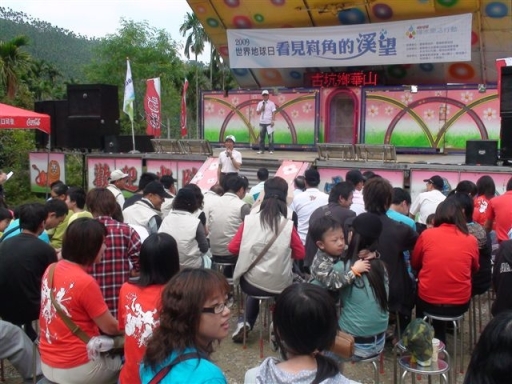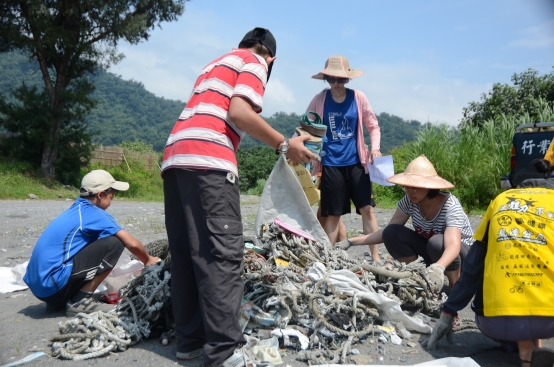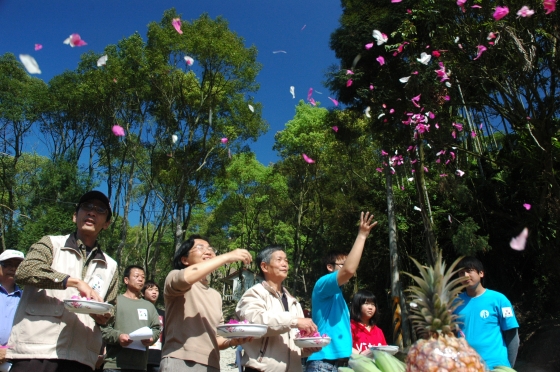

雲林縣華南國小暨樟湖國中小校長 陳清圳
壹、前言
面對廿一世紀充滿變動與挑戰的社會,教育不僅須配合社會變遷,掌握時代的脈動,也要引導,帶動社會進步,以迎向更美好的生活。教育並非等同於學校教育,所以,教育改革不能只在學校內進行,必須超越學校藩籬,將家庭、學校、社會三者結合,而社區即為三者融合的基本單位,所以「學校社區化,社區學校化」是推行社會教育的主流,也是當前教育改革的主要目標之一。
也由於學校和社區這種彼此親密連結,互助、共享的特性,亦即所謂生命共同體的社區認同感,加上學校以環境教育作為與社區互動的主軸,學校透過課程強化環境教育的概念認知和價值澄清的過程,藉以發展瞭解和讚賞介於人類、文化、和其生物、物理環境相互關係所必需的技能和態度。因而,透過課程與活動的施作,企圖達成環境覺知與敏感度、環境概念知識、環境價值觀與態度、環境行動技能與環境行動經驗育的環境教育目標。
本文主要是以雲林縣古坑鄉華南國小為中心,建立以一個學校結合社區發展的環境教育建構模式。這些過程主要是以學校和社區環境學習中心為出發點,試圖讓社區的議題生活化;在時間上,讓社區的歷史文化、自然資源等,藉由課程的脈絡找回傳承;在空間上,整合資源、營造更優質的生活環境,同時也讓社區低迷的產業,藉由彼此的合作得以轉型。
![]()
貳、推動社區環境教育的幾個步驟
學校和社區合作的幾個重點,首先必須瞭解社區的現況,尋找出可行的方法和策略:從資源的調查、社區共識的取得、人員的培訓等,都是推動過程中重要的工作。這也是學校和社區發展環境教育計畫中雙方必備的基礎。
一、 走訪與信任
從事社區工作,必須建立學校與社區彼此信任的關係。因為不論是實施學校教育或社區教育,必須要在理念產生聯結。學校與社區二者的關係,就文化觀點而言,不論是資源共享或彼此合作,均為學校與社區文化互動的形式之一,亦是個人與組織間或組織與組織間的互動關係,可以說它是一種文化的功能。因為教育與文化這兩個概念有一種內在的交叉、連環,不能分解的關係,絕不能夠在兩者之間,劃出一條明確的界線。
二、 資源盤點與調查
社區發展第二階段是資源的掌握。透過系統的調查,可以讓社區特色被發現。因此,學校可以自己設計調查方法,也可以申請專案計畫來進行資源的了解。華南國小這幾年帶領學生從事各種調查,可以讓學生透過主題課程,深入去了解當地的資源,同時也深化孩子的學習基礎,這幾年包含人物訪談;蛙類、蜻蜓、螢火蟲、蝴蝶、植物等調查,都陸續在進行,並將調查結果應用在社區活動中,這就是資源盤點的應用。
三、 策略規劃
進行策略規劃有助於提升成員的共識;再者讓組織成員清楚知道社區的現況與未來面對的困難與方向;方案規劃有助於社區掌握重點;最後,策略規劃所採取的行動方案,比較有執行的效率。因此從組織願景(vision)的形塑、團隊使命(mission)、信念與價值(Beliefs
and Values)、組織面對的困境與挑戰,與後續的行動方案等。透過策略規劃,有助於社區居民擘劃未來。
四、 社區人力培訓
透過社區人力培訓課程,強化社區居民的動能與共識。包含座談、故事敘說、信任活動、社區環境認識、彩繪社區、綠色地圖製作、導覽員培訓以及成果發表等,可將社區的動能帶出來,也讓社區的活動被其他居民看見。
五、 課程(活動、計畫)的擬定與實施
社區培訓課程後,針對特定主題進行導覽員培訓。學校與社區長期進行校外教學課程合作。首先由學校的校本課程出發,例如:學校本位課程「戀戀嵙角溪」,首先賦予教師對校本課程的設計專業,期能以當地資源,設計出生活化的課程,提高學生的學習興趣,提升學生多元能力。「戀戀嵙角溪」有十二個單元活動。在課程實施後,我們將其中兩三個活動轉移給社區導覽員,包含認識溪流、水質檢測、溪流體驗等,並將課程活潑趣味化。期待外地學生參與社區課程時,能更有吸引力。因此,從室內課程搭配室外課,讓帶隊者有更豐富的實務經驗。
六、 反省與檢討
透過課程理解、實踐與反思;有助於學校課程的深化。同時社區經營也必須清楚目標、實施與反省改進三個步驟。因此,必須有能夠有人扮演觀察者;或者設計問卷回饋。針對學習者的問卷回饋,有時社區會很難接受批評,但是追求品質的方向不變下,適時適地的提醒參與者關鍵問題的掌握,才能不傷和氣又能真正地檢討改進。
叁、空間的營造
一、
小地方的改變
1. 綠美化:
社區最普遍進行的計畫就是社區綠美化。社區綠美化包含社區清掃、髒亂地綠化、美化以及裝置藝術、生態綠籬、步道建置等。這樣的計畫可以向環保局(署)申請的清淨家園計畫、水保局的社區綠美化、林務局的植樹活動等。學校可以扮演計畫撰寫的角色,由於社區通常缺少計畫撰寫的人才,由學校協助計畫的撰寫,通常計畫較具完整性。計畫在社區理監事和總幹事的同意後,並取得綠美化土地施作同意書。透過雙方的合作,由社區負責同意書的取得、志工名冊的建立(如果沒有志工隊,盡量成立),學校端撰寫計畫,完成計畫後送件,當然沒有經費也可以進行社區的工作。計畫開始實施後,由社區方面開始號招志工,進行定期的清掃工作;同時進行社區髒亂地的清除與綠美化,重要的轉角、社區醒目的地方,都是初期綠美化重要的施作地點。實施過程應該有前中後三階段的照片比對,完工後可以立解說牌,可讓居民看到社區的改變的過程。
2. 牆面的改變:
將社區殘破的圍牆改成綠籬或去除不要;也可以改成具較強的功能性座椅、藝術造型,這都是社區小空間的改變。而大部分的社區也進行壁面彩繪工作,唯能夠喚醒居民的共同參與,而不是外包給其他單位,這才是社區營造的首要工作。
3. 生態環境:
社區的工作,最具挑戰的項目之一是生態環境的復育與創造。例如:建置水生池前必須評估水源、該地的資源(蛙類、蜻蛉)適不適合興建水池。蜜源植物的選擇也要謹慎評估,包含花期、外來種問題以及後續植物會產生怎樣的變化,評估好後再實施推動。另外,如果已經有水池的社區,也可以試著改變,包含水溝淤泥的清除、水池的循環與淨化,都是讓社區朝向生態化。我們也曾經用當地的竹材,做成浮島,種植空心菜與水生植物,讓原本單調的水池,開始有了生命力。
4. 家戶綠美化:
公共區域仰賴大家的參與與維護。而住家裡更需要改變。因此社區可體提供花器與資材,讓住家也可以種植花草;並選擇適當的時間,進行評比與鼓勵,這樣可以激勵社區全面的改變,同時後續的維護,也比較容易。
5. 以幸福為名的有機菜園:
孩子到學校,最主要的事,就是學會與真正的世界連結。所謂真正的連結不是表面或浮淺的人際關係,而是要孩子的主體經驗在不同時空背景下,與當時的人們探索創造過後的世界相連結,但連結的方式不是不經整理的拼湊接合,而是讓孩子透過生活與思維,使他原來的經驗網路不斷的向外延伸。
因此學校課程的設計,以室內課程搭配戶外學習,以拓張孩子觀察力與敏感度,讓孩子驚覺生命無所不在的喜悅;課程的設計要讓孩子思考活潑化,在觀察體會後深化邏輯思考的能力;課程要能讓孩子的情感內涵擴展,誠實面對自己的感受,學會表達真誠、顯現更闊達的喜悅;課程能夠讓孩子生活態度改變,拉近人與人、人與社會、人與土地關係。讓孩子能夠從直覺、瞭解到醒覺。
從土地出發,有機菜園可以讓孩子接近土地。在華南國小學習三部曲,從體驗操作,認識土地和產業;深入探索與理解產業;行動關懷幫助產業。
![]()
二、 環境學習中心
1. 課程主題的選定:環境學習中心,泛指擁有環境特色的地區,能提供適當的場域、展示、教育、設施與活動,透過專業人員的解說、引導及教育,使各年齡的對象,能在環境中體驗自然的美好,珍視環境與資源的可貴,學習環境的知識,探索人與環境互動與互賴的關係,並培養對環境負責任的行為。也就是說環境學習中心是整合社區各種資源朝向系統化發展的重要概念。這幾年華南國小與社區開始利用當地的資源,經設計轉化後進行推廣。包含夜間觀察、溪流體驗、咖啡DIY、檳榔樹屋搭設、自然步道導覽、植物素材DIY、植物染、能源課程、傳統老屋或古文物解說等活動等。
2. 學習場域:社區最困難的部份應該是學習空間的建置。大部分的社區都會有活動中心,如果可以合作的話,可以同時發展成展示、上課與活動的空間,空間基本需求應該具有容納三四十人的條件。設置學習空間,在學校容易受到干擾,但是比較有足夠的設施。社區的空間與設備通常比較不完備,但是比較不會干擾學校的上課。
3. 環境教育認證人員:一般而言,當有足夠的條件成立環境教育中心時,不管是學校或者是社區,都要有人朝向環境教育人員認證的目標前進,這樣才能維繫中心的品質與開創新的課程內涵。
4. 專家學者資源:學校經營發展必須整合各方資源,並按照學校的課程計畫,逐步實施,這樣才能逐步提升學生的學習品質。因此,學校經營要能夠分析學校人力與特長,引進大學與企業資源,與社區合作,將資源投入到課程經營上,這樣才能將有限的資源發揮到極致。
肆、社區環境教育課程案例分享
保育工作一般在社區推展是有相當的困難度,可以利用課程的方式,帶有一點創意,進行學校與社區合作推動的模式。大華山地區在九二一之後,遇到土石流的衝擊,也開始進行重建工作。然而資源過度投入,反而造成過度的開發。因此,華南國小推動社區保育工作時,首先反省經濟的運作需要納入環境的考量來評估價值、效能與發展的得失。一種不會損及未來世代的環境與經濟選項的永續性,才是社區追求的目標。為達到此目標,學校開始進行課程的實施與活動的推廣。
初期學校並不直接跟社區居民談保育,而是用活動參與的方式,讓居民直接感受這塊土地散發出來的生命力,同時帶給社區有想像空間後,才付諸保育的執行。這種不談保育的保育方式,我們在大華山地區進行幾次的推動經驗,例如:嵙角溪的保育、生態祭典的啟動、生態結合產業的活動等。
環境教育案例分享
(一)溪流課程與社區參與
社區有一條未受汙染的河川,溪名為嵙角溪。初見時著實令人感動,裡面除了水質清澈,同時也富含化石與自然資源;相對於另一條華山溪,因為土石流關係已被整治成人工化的溝渠狀態。我們從帶著孩子到溪裡去體驗開始,逐漸地讓孩子對這條溪充滿了感情和興趣。
有一天社區理事長突然跑來找我,談到他的想法:
「校長,我已經請相關單位來現勘,我準備把河川整治成階梯狀,這樣讓河川看起來比較乾淨一點。」
「乾淨一點?可是我看溪水很乾淨啊!河川有土石沖刷的危險嗎?」我驚訝的問到。
「沒有啦,但是政府那邊有錢,聽說只有跟他們申請,就可以進行整治工程。」理事長補充。
我聽到這些話時,我心裡面著實震驚,因為雲林難得有這麼一條優質無汙染的水域,靠的是兩岸鬱鬱蔥蔥的樹林庇護,如果將這些植被剷除,未來河川的命運不可得而知。但是我知道直接跟居民遊說應該沒有用,必須再更進一步想一些策略。
於是我開始啟動學校的溪流課程,從廣泛的認識到深度的探究,最後採取行動關懷的三個步驟。
約莫七月初,我再度邀約理事長,請他協助孩子的溯溪活動,我用「溯溪」這名詞,聽起來比較專業,也容易打動理事長。
「理事長,可以來幫忙嗎?孩子溯溪需要人手,剛好我這邊有一些計畫經費可以支應!」我向理事長提出建議。
「協助孩子?」理事長眼裡有點迷惑
「對啦!你對溪裡的狀況比較熟悉,而且依你的專業提醒我,哪裡有危險要避開。」
就這樣,我們把孩子集合去溯溪,孩子的表現遠超乎我預期,除了展現主動求知道慾望外,竟然還要求下次再來,這超出理事長的想像。因為他以前參與水保單位的帶隊解說活動,孩子常常索然乏味,主要原因是,孩子對於跟他無關的「知識」,根本提不起興趣,因此每當解說完後,通常沒有人會要求再度前來,更不可能展現高度的求知慾望。
孩子下水玩了幾次後,我主動跟理事長提出建議:
「理事長,如果把河川整治掉,以後就少了可以溯溪的場所,多可惜啊!」
「說的也是!」理事長回答
「如果我們來推廣溯溪活動,收一點經費,這樣比整治後毫無用處,未來反而比較有更大的推廣空間。」我開始提出要求。
「不錯的想法。」理事長的眼睛閃露出光芒…
「對啦,你趕快去跟政府單位說,我們不要做了整治工程,要改做生態體驗活動!」我直接說出目的。
當我說服理事長後,也和他著手舉辦社區會議,這場由孩子解說的社區說明會,直接促成社區河川巡守隊的成立,也開始讓社區獲得許多的保育獎項。嵙角溪在我們共同努力下,暫時保住了生機,也讓社區對嵙角溪的「用途」有了新的認識。
「認識」其實很困難,但是通常掌握了一些關鍵,就不難推展。
對於學校,除了課程還是課程。我們開始有系統地去設計一些課程活動。相對於社區,課程必須轉化成簡單的活動,讓居民可以上手,同時需要有多樣的活動樣貌。因此,開始找了一些社區的夥伴,來學校參加導覽員的培訓。我不是要教他們認識甚麼?更重要的是,要告訴這些夥伴,當你準備好想做甚麼時?你的生活與生命,將會開始改變。
 |
 |
| 溪流課程 |
淨溪淨山 |
![]()
(二) 生態祭典的啟動
大華山地區這幾年由於過度的開發,加上十幾年來發展咖啡產業,轉型觀光化後車流量大增,旅遊人口湧入,民宿、咖啡廳、餐廳林立,自然棲地逐漸消失;也經常有青蛙、蛇等爬蟲類;獨角仙或鍬型蟲等昆蟲慘遭壓死,光害造成螢火蟲數量銳減,擴音機音量震耳欲聾嚇走鳥類,排放廢水汙染河川;為增加農作產量,大量噴灑農藥等,均造成野生動物的極大死傷。觀光熱潮退卻後,環境改變已成不可逆的事實,野生動植物蒙受的災難一時尚不能復原。因此在核心幹部的討論中,深入的思考如何保育山林,更重要的是如何從生活中,讓居民深刻的感受與遵守保育規範,於是帶有宗教色彩的生態祭典,醞釀而生。
生態祭典主要的訴求是:呼籲在地居民與遊客在進入咖啡園區時能減速慢行,禮讓動物過馬路;並進行山林復育,不使用除草劑或農藥,減少夜間光照度,讓萬物休養生息,做到繁殖季能夠不干擾、不破壞、不使用藥劑。
大華山生態祭典活動(惜山祭、告天祭、謝天祭),主要是凝聚社區居民參與環境保育的共識。主要的方式是透過聯署,徵求大華山地區的私有土地(100年度60公頃;101年度85公頃;102年度的127公頃),在繁殖季時至少一個月的半封山
(不破壞、不噴藥、不干擾),同時透過教育宣導,讓民眾遊客能夠放慢行車速度,減少生物路死意外。社區在三月春分時期,透過由鄉長主祭,舉辦惜山祭;四月穀雨時期,舉辦告山祭,向上天表白,社區會用對環境比較溫和的方式,進行為期半年的導覽解說與體驗活動,讓參與者深化環境智能。活動有溯溪、夜觀、導覽。也同時進行溪流監測、環境調查活動,以期在活動進行期間,不要對環境產生大的衝擊與破壞;十一月立冬時期,再舉辦謝天祭,除了感謝天地帶給社區一年的風調雨順,五穀豐收,也透過自省,友善環境。謝天祭時期,學校會募集物資,分送給弱勢家庭。
祭典儀式以莊嚴為重,展現居民對環境的愛護,強化保護山林的決心,並邀請媒體業者共同見證。
 |
| 惜山祭 |
(三)生態結合產業的課程
學校與社區每季推出不同的主題活動,有賞螢,賞蛙、賞蝶課程,採用定點解說活動,與當地的餐廳業者合作,在每個周末假期的夜晚,進行主題導覽。目的是希望遊客來社區消費之外,還有一些學習課程,讓遊客與餐廳業者互蒙其利,一方面可以提振產業,一方面可以灌輸保育觀念。而這些活動可以採用收費,也可以由專案計畫支持。
(四)戶外教學的推動
社區申請專案計畫,提供給其他學校前來體驗學習,課程包含夜間觀察、溪流體驗、咖啡DIY、檳榔樹屋搭設、自然步道導覽解說、植物素材DIY、植物染、傳統老屋解說等活動。從社區開始推動相關計畫之後,每年都超過五千人次到社區學習,在2011年更是超過一萬人次,龐大的學習人潮讓我開始進行環境品質監測計畫。
(五)可以接受的範圍:棲地品質監控
頻繁的遊學活動加上遊客的進入,對環境會產生衝擊。我們開始進行環境監測。包含螢火蟲、蛙類的棲地品質和種數是否減少;水質是否受到汙染,這都是社區的環境監測活動。
(六)綠色標章推廣:
雲林、嘉義分布諸羅樹蛙,由於樹蛙主要生活在人為的竹林與農耕地,加上數量稀少,因此被列為二級保育動物。要保育諸羅樹蛙,無法劃定保育區,因此如何增加諸羅樹蛙的棲地品質與面積,是保育的重要課題。因此,提出綠標計畫,協助竹筍的銷售,以生態指標為基礎,進行綠標竹筍的認證。
 |
 |
| 地質教學 | 賞蛙課程 |
Changchun Chen
Principal of Huanan Elementary School
and Janghu Elementary& Junior High School
Innovation in education happens not
only on campus but also beyond the campus, so the community inevitably should be
included. Huanan Elementary School
in Yunlin County is a model of school-community partnerships in Environmental
Education. The school tries to make
the school community be aware of local environmental issues, to rediscover the
natural and cultural resources with curricula, and to improve the local business
by resource integration as well as environment improvement.
Finding out feasible strategies after
a community review is an indispensable foundation of school-community
cooperation. Steps of Engaging the
Local Community in Environmental Education (EE) are below.
Most good community projects are
built on a trusting relationship between schools and communities.
Schools can interact with local communities by sharing resources or
working on projects together.
Carrying out a systematical
environmental review helps the local communities to be discovered.
In Huanan’s school-based curriculum,
the pupils identify local resources through community menber interviews as well
as nature surveys, e.g. frog survey, firefly survey, plants survey, etc.
Then the results they gathered can be used in community actions.
The process of making action plans
helps the community identify its environmental strength, weakness, and
challenges.
Empower the community members through
forums, local narratives, community painting, green maps making, local guide
training, etc.
Local guide training can be started
from school-based curricula. In
Huanan Elementary School’s Stream Curriculum, school teachers design twelve
learning activities. Then, three of
them are directly installed in its local guide training program, including
stream guide, water quality analysis, and outdoor recreation.
The regular feedback from
observations and participants’ questionnaires helps the curriculum be improved.
(1) Greenification of Communities
Greenification of communities is the
most common way for community environment improvement, such as community
cleanup, environmental arts, spare space greenification, hedges and nature
trails construction, etc. Schools
can be in charge of writing funding proposals for community greenification
projects, and the local community personnel can be in charge of getting local
authorizations, recruiting community volunteers, and other greenification works.
Moreover, it’s important to display these before-and-after photos, thus the
residents can see the environment improvement from photo comparisons.
(2) Space Transformation
To raise environmental awareness in
communities, it’s crucial to encourage residents to participate in space
transformation project, such as hedge construction as well as environmental art
implementation.
(3) Community Ecologization
Community ecologization is one of the
most challenging tasks. For example, before building an ecological pond, local
environmental review and analysis are required.
Also, before planting honey plants, the possible influences or impacts on
local environment must be taken into consideration.
Communities already having ecological ponds can try to keep the ponds
alive by removing the fill and planting aquatic plants.
(4) Greenification in Families
In addition to making public spaces
green, keeping each home green is also crucial.
The feasible strategies may be offering residents plants and flowerpots,
or developing an environmental evaluation with rewards.
(5) Organic Farms
The real learning for pupils is to
immerse them in the education that real life provides.
Therefore, to raise pupils’ environmental perceptions and awareness,
schools can design curricula with indoor and outdoor learning activities.
Huanan’s organic farming curriculum is an example. It involves three
stages: getting to know the nature and local economies with real experiences,
conducting an investigation into local economies for deeper understandings, and
then helping local economies with actions.
(1) Curriculum Topic
Environmental Learning Center (ELC)
is a regional center for environmental education and outdoor recreation for all
ages. Environmental learning
experiences, provided by professional environmental educators, are in an attempt
to increase participants’ environmental awareness and actions. Huanan Elementary
School and its local community have made good use of local resources and
developed several learning programs, including nocturnal observation, stream
recreations, coffee DIY, betel nut tree house building, nature guides, natural
dyeing, energy courses, local heritage and housing guides.
(2) Location
Finding the right location for ELC in
community is a big challenge. If
there is a community center with a capacity of 30 to 40 people, that will be a
perfect ELC location for displays, lessons or activities.
(3) Certified Professional Environmental Educator
Encourage school staff and community
personnel to be certified professional environmental educators, so that the
ELC’s working quality and curricula can be ensured and improved.
(4) Scholars and Specialists
Human Resources Integration
To improve the learning quality,
schools can conduct a community human resources analysis. Then, integrate human
resources of enterprises, universities, and the community to curriculum
management.
There is an unpolluted stream in Huanan Elementary School’s community, so
we engage the pupils in water experiences.
One day, the director of local community told me (the principal) his plan
of constructing ladder-like embankments to keep the stream clean.
I was astonished and worried about the upcoming impacts on local
environment. Thus, I start the
school-based curriculum of Stream.
It contains three steps: environmental understanding, environmental inquiry, and
environmental actions.
In July of that year, I asked the community director for help in school’s
stream trekking learning. The
community director was surprised that pupils keep high motivations in stream
learning. “Director, it’s a pity
that there’ll be no place for pupils’ stream trekking learning after that
construction.” I said. “Right,” the
community director answered. Then I
persuaded the community director to develop eco-tours for profits, instead of
constructing artificial structures in water.
The director agrees with my idea.
Afterwards, we held a community meeting hosted by our pupils, and form a
community stream-keeper team. With
the efforts we’ve made, the community is awarded with several eco prizes, and
the stream is also saved.
In school, school teachers systematically design curricula and
learning activities. As for the
community, we invited community members to the guide training program, and offer
them several simplified learning activities that they can used in local tours.
In Huashan Area, there were
environmental damages caused by improper use of pesticides as well as negative
impacts of coffee tourism. To
increase community residents’ environmental awareness and actions, some members
decide to hold eco festivals. The
aims of eco festivals are to: educate visitors and community members to slow
down or stop while meeting any animal in the road; regulate the use of
pesticides for environmental recovery; and reduce artificial night lights in
fireflies mating season. What eco
festivals includes are below.
(1) Mountain Festival
In March, we hold Mountain Festival.
We claim to protect the mountains and work on landowner authorizations
(no damages, no pesticides, and no disturbing during the breeding season.)
Then, the local government awards those
landowners certificates of appreciation.
(2) Heaven Festival
In April, it’s time for harvest, so
we hold Heaven Festival. We promise
to improve public environmental knowledge with tour guides and activities in the
following six months, such as stream trekking, nocturnal observation, and nature
guides. Besides, to minimize the
impact of those activities, we work on water quality monitor and environmental
surveys in this period.
(3) Thanksgiving Festival
In November, it’s time for joy and
thanksgiving, so we celebrate Thanksgiving Festival by collecting donations for
those local residents in need.
The school as well as its community
provides various eco tour packages, including fireflies guide, frogs guide, and
butterflies guide. Also, local
restaurants are involved and offer some related courses on weekend nights.
In this way, we can maximize economic benefits for the local community
and improve community members’ environmental knowledge.
The local community offers
environmental educational tours to other schools, such as nocturnal observation,
stream recreations, coffee DIY, betel nut tree house building, nature guides,
natural dyeing, local housing guide.
Since this tour project starts, we welcome over 5,000 visits each year, and more
than 10,000 visits in 2011.
To minimize the negative
environmental impacts of tourist growth, we regularly monitor the quality of
fireflies’ and frogs’ habitats, their populations, and water quality.
Farmland Green Tree Frogs, living in
agricultural areas of Chiayi and Yunlin, are second-class national protected
species. To protect Farmland Green Tree Frogs’ habitat, ecolabel certification
project is developed and applied to promoting eco-friendly bamboo shoots.
In these years, we found the pupils and school community have been
improved with Huanan’s school-based curriculum.
Therefore, schools should work together with the communities.
And forming school-community partnerships and integrating local resources
are important tasks.